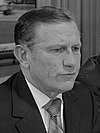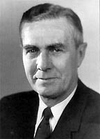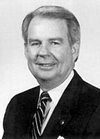Federal Highway Administration
 | |
| Agency overview | |
|---|---|
| Formed | April 1, 1967 |
| Preceding agency |
|
| Jurisdiction | Federal government of the United States |
| Headquarters | Washington, D.C. |
| Annual budget | $46 billion (FY2019)[1] |
| Agency executives |
|
| Parent agency | Department of Transportation |
| Website | www |
The Federal Highway Administration (FHWA) is a division of the United States Department of Transportation that specializes in highway transportation. The agency's major activities are grouped into two programs, the Federal-aid Highway Program and the Federal Lands Highway Program. Its role had previously been performed by the Office of Road Inquiry, Office of Public Roads and the Bureau of Public Roads.
History
[edit]Background
[edit]With the coming of the bicycle in the 1890s, interest grew regarding the improvement of streets and roads in America. The traditional method of putting the burden on maintaining roads on local landowners was increasingly inadequate. In 1893, the federal Office of Road Inquiry (ORI) was founded; in 1905, it was renamed the Office of Public Roads (OPR) and made a division of the United States Department of Agriculture.
Demands grew for local and state government to take charge. With the coming of the automobile, urgent efforts were made to upgrade and modernize dirt roads designed for horse-drawn wagon traffic. In 1910, the American Association for Highway Improvement was organized. Funding came from automobile registration, and taxes on motor fuels, as well as state aid. By 1914, there were 2.4 million miles of rural dirt rural roads; 100,000 miles had been improved with grading and gravel, and 3,000 miles were given high-quality surfacing. The rapidly increasing speed of automobiles, and especially trucks, made maintenance and repair high-priority items.
In 1915, OPR's name was changed to the Bureau of Public Roads. The following year, federal aid was first made available to improve post roads and promote general commerce: $75 million over five years, issued through the BPR in cooperation with the state highway departments.[2][3]
In 1939, BPR was renamed to the Public Roads Administration (PRA) and shifted to the Federal Works Agency. After the FWA was abolished in 1949, the organization was once again named the Bureau of Public Roads; it was placed under the Department of Commerce.[4]
From 1917 through 1941, 261,000 miles of highways were built with $3.17 billion in federal aid and $2.14 billion in state and local funds.[a]
Creation
[edit]The Federal Highway Administration was created on October 15, 1966, along with the Bureau of Motor Carrier Safety and the National Highway Safety Bureau (now known as National Highway Traffic Safety Administration), as part of the new U.S. Department of Transportation.[6] The FHWA took over the functions of the Bureau of Public Roads the following year.
Functions
[edit]The FHWA's role in the Federal-aid Highway Program is to oversee federal funds to build and maintain the National Highway System (primarily Interstate highways, U.S. highways and most state highways). This funding mostly comes from the federal gasoline tax and mostly goes to state departments of transportation.[7] The FHWA oversees projects using these funds to ensure that federal requirements for project eligibility, contract administration and construction standards are adhered to.
Under the Federal Lands Highway Program (sometimes called "direct fed"), the FHWA provides highway design and construction services for various federal land-management agencies, such as the Forest Service and the National Park Service.
In addition to these programs, the FHWA performs and sponsors research in the areas of roadway safety, congestion, highway materials and construction methods, and provides funding to local technical assistance program centers to disseminate research results to local highway agencies.
The FHWA also publishes the Manual on Uniform Traffic Control Devices (MUTCD), which is used by most highway agencies in the United States. The MUTCD provides such standards as the size, color and height of traffic signs, traffic signals and road surface markings.
Programs
[edit]Long-Term Pavement Performance Program
[edit]Long-Term Pavement Performance (LTPP) is a program supported by the FHWA to collect and analyse road data. The LTPP program was initiated by the Transportation Research Board (TRB) of the National Research Council (NRC) in the early 1980s. The FHWA with the cooperation of the American Association of State Highway and Transportation Officials (AASHTO) sponsored the program. As a result of this program, the FHWA has collected a huge database of road performance. The FHWA and the ASCE hold an annual contest known as LTPP International Data Analysis Contest, which is based on challenging researchers to answer a question based on the LTPP data.[8]
Every Day Counts initiative
[edit]In 2010, FHWA launched the Every Day Counts (EDC) initiative to identify and deploy innovations to reduce project delivery time, enhance safety, and protect the environment.[9][10][11][12] EDC is a state-based model that rapidly deploys proven, yet underutilized innovations. FHWA works with State transportation departments, local governments, tribes, private industry, and other stakeholders to identify a new collection of innovations to champion every two years that merit accelerated deployment. Among the approaches promoted by the EDC effort are: adaptive traffic control to reduce fuel consumption and improve travel time reliability; alternative intersection design; prefabricated bridge elements and systems; high-friction surface treatments; warm mix asphalt; ultra-high-performance concrete; virtual public involvement; and time-saving strategies such as rapid bridge replacement.[13] Since the inception of EDC, each state has used 26 or more of the 57 innovations and some states have deployed more than 45. Many of these practices have become mainstream practices across the country.[14]
Organization
[edit]The Federal Highway Administration is overseen by an administrator appointed by the President of the United States by and with the consent of the United States Senate. The administrator works under the direction of the Secretary of Transportation and Deputy Secretary of Transportation. The internal organization of the FHWA is as follows:[15]
- Office of Administration
- Office of Chief Counsel
- Office of the Chief Financial Officer
- Office of Civil Rights
- Office of Federal Lands Highway
- Office of Infrastructure
- Office of Innovation and Workforce Solutions
- Office of Operations
- Office of Planning, Environment, and Realty
- Office of Policy and Government Affairs
- Office of Public Affairs
- Office of Research, Development, and Technology
- Office of Safety
Administrators
[edit]| Portrait | Administrator | Term started | Term ended |
|---|---|---|---|

|
Roy Stone | October 3, 1893 | October 13, 1899 |

|
Martin Dodge | January 31, 1899 | 1905 |

|
Logan Waller Page | 1905 | December 9, 1918 |

|
Thomas Harris MacDonald | April 1, 1919 | March 31, 1953 |

|
Francis Victor du Pont | April 1, 1953 | January 14, 1955 |

|
Charles Dwight Curtiss | January 14, 1955 | October 1956 |

|
John A. Volpe | October 22, 1956 | February 5, 1957 |

|
Bertram D. Tallamy | February 5, 1957 | January 20, 1961 |

|
Rex Marion Whitton | January 20, 1961 | December 30, 1966 |

|
Lowell K. Bridwell | March 23, 1967 | January 20, 1969 |

|
Francis Turner | March 13, 1969 | June 30, 1972 |

|
Ralph Bartelsmeyer (acting) | July 1, 1972 | June 1, 1973[16] |

|
Norbert Tiemann | June 1, 1973 | March 31, 1977 |

|
William M. Cox | April 7, 1977 | May 1, 1978 |

|
Karl S. Bowers | April 3, 1978 | January 1980 |

|
John S. Hassell Jr. | July 11, 1980 | February 5, 1981 |

|
Ray Barnhart | February 12, 1981 | December 31, 1987 |

|
Robert E. Farris | June 8, 1988 | May 17, 1989 |

|
Thomas D. Larson | August 10, 1989 | January 20, 1993 |

|
Rodney E. Slater | June 3, 1993 | February 14, 1997 |

|
Kenneth R. Wykle | December 2, 1997 | September 4, 2001 |

|
Mary E. Peters | October 2, 2001 | July 29, 2005 |

|
J. Richard Capka | May 31, 2006 | January 24, 2008 |

|
Thomas J. Madison Jr. | August 18, 2008 | January 20, 2009 |

|
Victor Mendez | January 20, 2009 | July 24, 2014 |

|
Gregory G. Nadeau | July 30, 2014 | January 20, 2017 |

|
Brandye Hendrickson (acting) | July 24, 2017 | May 6, 2019 |

|
Nicole Nason | May 7, 2019 | January 20, 2021 |

|
Stephanie Pollack (acting) | February 24, 2021[17] | January 13, 2023 |

|
Shailen Bhatt | January 13, 2023 | Incumbent |
Deputy administrators
[edit]- D. Grant Mickle October 27, 1961[18] – January 20, 1964
- Lowell K. Bridwell (acting) January 20, 1964 – March 23, 1967[19]
- Ralph Bartelsmeyer August 10, 1970 – January 25, 1974[20]
- Joseph R. Coupal Jr September 30, 1974[21] – 1977[22]
- Karl S. Bowers June 5, 1977[23] – August 3, 1978[24]
- John S. Hassell, Jr. August 31, 1978 – July 11, 1980
- Alinda Burke August 8, 1980[25] – ?
- Lester P. Lamm September 17, 1982 – 1986
- Robert E. Farris August 8, 1986[26] - June 8, 1988
- Eugene R. McCormick June 30, 1989[27] - ?
- Gloria J. Jeff December 19, 1997[28] – January 3, 1999[29]
- Walter Sutton Jr (acting) January 3, 1999[30] – May 3, 2000[31] May 3, 2000 – January 2001
- J. Richard Capka August 5, 2002 – May 31, 2006[32]
- Kerry O'Hare November 10, 2008[30] – January 20, 2009
- Gregory G. Nadeau July 8, 2009 – July 30, 2014
- Brandye Hendrickson July 24, 2017 – October 9, 2019
- Mala Parker October 10, 2019 – January 20, 2021
- Stephanie Pollack January 27, 2021 – February 1, 2023
- Andrew Rogers February 27, 2023 – January 2024
- Kristin White May 20, 2024 – Current
Executive directors
[edit]- Lester P. Lamm, August 8, 1973[30] – ?
- Thomas D. Everett, October 22, 2018 – June 30, 2022[33]
- Mayela Sosa (Acting), June 30, 2022 - October 20, 2022
- Gloria M. Shepherd, October 20, 2022 - Current
See also
[edit]- Federal Motor Carrier Safety Administration
- Highway Gothic
- Intelligent Transportation Systems Institute
- Intelligent Transportation Systems
- National Transportation Communications for Intelligent Transportation System Protocol (NTCIP)
- Title 23 of the Code of Federal Regulations
- U.S. Department of Transportation
Notes
[edit]References
[edit]- ^ "Consolidated Appropriations Act, 2019" (PDF). One Hundred Sixteenth Congress of the United States of America. 2019-01-03.
- ^ Faulkner, Harold U. (1951). The Decline of Laissez Faire, 1897–1917. pp. 233–236.
- ^ Dearing, Charles Lee (1942). American Highway Policy.
- ^ Weingroff, Richard (September 28, 2017). "The Trailblazers: Brief History of the Direct Federal Highway Construction Program". Highway History. Federal Highway Administration. Retrieved August 17, 2020.
- ^ United States Census Bureau (1976). Historical Statistics of the United States. F1, Q64-Q68. pp. 224, 711.
- ^ "Highway Existence: 100 Years and Beyond". Public Roads. Federal Highway Administration. Autumn 1993.
- ^ "What is the Highway Trust Fund, and how is it financed?". Tax Policy Center. Retrieved March 18, 2020.
- ^ "Transportation & Development Institute (T&DI) of the American Society of Civil Engineers (ASCE) and Long-Term Pavement Performance (LTPP) International Data Analysis Contest". Federal Highway Administration.
- ^ Schroeder, Bastian; Cunningham, Chris; Ray, Brian; Daleiden, Andy; Jenior, Pete; Knudsen, Julia (August 2014). Diverging Diamond Interchange Informational Guide (PDF). Washington, DC: Federal Highway Administration Office of Safety.
- ^ "EDC-1: Adaptive Signal Control Technology". Federal Highway Administration.
- ^ Dowsett, Emily (January 31, 2019). "APWA Announces Public Policy Priorities for 116th Congress" (Press release). American Public Works Association – via GlobeNewswire News Room.
- ^ "FHWA Launches Fifth Round of 'Every Day Counts' Program". For Construction Pros.
- ^ "Every day counts initiative". Federal Highway Administration.
- ^ "About Every Day Counts". Federal Highway Administration (FHWA). Retrieved May 13, 2024.
- ^ "FHWA Organization". Federal Highway Administration. Retrieved March 15, 2018.
- ^ "January 25". FHWA By Day. Highway History. Federal Highway Administration.
- ^ "FHWA Organization". Federal Highway Administration.
- ^ "October 27". FHWA By Day. Highway History. Federal Highway Administration.
- ^ "March 23". FHWA By Day. Highway History. Federal Highway Administration.
- ^ "January 25". FHWA By Day. Highway History. Federal Highway Administration.
- ^ "100th Anniversary: An Evolving Partnership". Public Roads. Federal Highway Administration. November–December 2014. FHWA-HRT-15-001.
- ^ Transportation: Current Literature - Volume 59 - Page 3. U.S. Department of Transportation, Library Services Division. 1980.
- ^ "Secretary of Transportation May 11, 1978 Memorandum to President Carter" (PDF). Jimmy Carter's Presidential Library.
- ^ "August 3". FHWA By Day. Highway History. Federal Highway Administration.
- ^ "August 8". FHWA By Day. Highway History. Federal Highway Administration.
- ^ Department of Transportation Related Agencies Appropriations 1989 House Hearings Before a Subcommittee of the Committee on Appropriations. US House of Representatives, One Hundredth Congress, Second Session Part 4. 1988.
- ^ U.S. Department of Transportation News FHWA. Department of Transportation, Office of Public Affairs. 1980.
- ^ "December 19". FHWA By Day. Highway History. Federal Highway Administration.
- ^ "Top FHWA Official Jeff Resigns". December 8, 1999.
- ^ a b c "On This Day in Automotive History... - the Crittenden Automotive Library". www.carsandracingstuff.com. Archived from the original on August 10, 2018. Retrieved January 15, 2022.
- ^ "May 15". FHWA By Day. Highway History. Federal Highway Administration.
- ^ "Along The Road". Public Roads. November–December 2002.
- ^ "FHWA Executive Director: Thomas D. Everett". Federal Highway Administration.
External links
[edit]- Official website
- Federal Highway Administration in the Federal Register
- Federal-Aid Highways account on USAspending.gov
- Highway Infrastructure Programs account on USAspending.gov
- Records of the Federal Highway Administration (Record Group 406) in the National Archives

